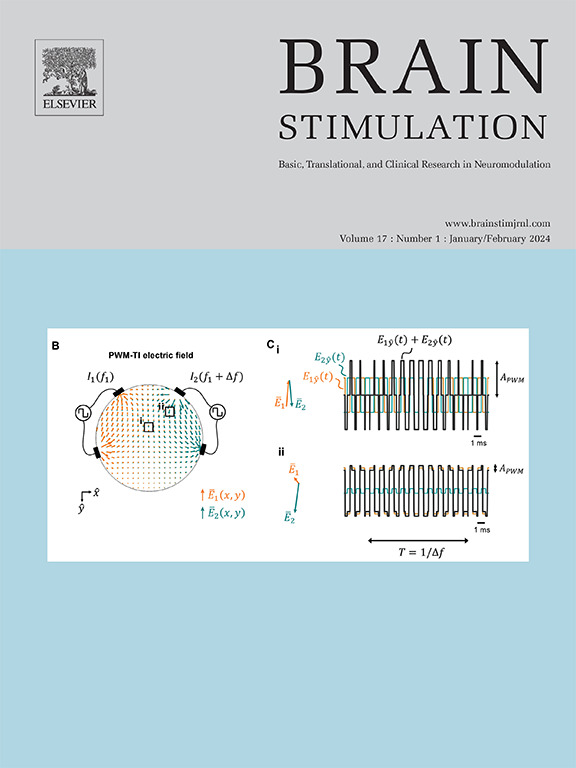Cell-type-specific responses to single-pulse electrical stimulation of the human brain
IF 8.4
1区 医学
Q1 CLINICAL NEUROLOGY
引用次数: 0
Abstract
Background
Currently approved human brain stimulation therapies, ranging from deep brain stimulation to responsive neuromodulation, use macro electrodes to deliver current to the brain. Despite daily clinical use, it remains fundamentally unknown how human neurons respond to intracranial stimulation.
Objective
We address this knowledge gap by characterizing cell-type-specific firing rate (FR) responses to broadly distributed single pulses of electrical stimulation as part of a common clinical procedure for epilepsy patients.
Methods
We recorded isolated neurons on microwires implanted into the medial temporal and frontal lobes of 30 epilepsy patients while stimulating macroelectrode contacts.
Results
Proportions of units classified as interneurons and principal cells corresponded with those previously reported. To see how stimulation affected neuronal activation, we calculated FR change between pre-stimulation and post-stimulation time windows and observed that from 174 modulated units 91 % showed FR suppression (Cohen's h = 0.77, large effect). We then characterized stimulation-evoked changes in FR to gain insight into cell-type-specific responses. Additionally, we observed that FR responses were modulated by stimulation distance, where local stimulation (within ∼40 mm) could evoke instantaneous firing, while distant stimulation reliably suppressed firing. Finally, we analyzed units within the seizure onset zone, revealing unique waveshapes and FR responses to stimulation.
Conclusions
This study bridges a gap in the neuromodulation field by examining the single-unit, cell-type-specific FR responses to direct electrical stimulation of the human brain. We show that low-frequency, single-pulse stimulation broadly elicits suppression, but parameters, such as distance, can have diverse effects on FR. This work informs the neuronal basis of stimulation-evoked potential generation, cell-type-specific responses to stimulation, and has clinical implications for the diagnosis and treatment of drug-resistant epilepsy.
细胞类型对人脑单脉冲电刺激的特异性反应。
背景:目前批准的人类大脑刺激疗法,从深部脑刺激到反应性神经调节,使用宏观电极向大脑传递电流。尽管临床每天都在使用,但人类神经元对颅内刺激的反应仍然是未知的。目的:作为癫痫患者常见临床程序的一部分,我们通过表征细胞类型特异性放电率(FR)对广泛分布的单脉冲电刺激的反应来解决这一知识差距。方法:在刺激大电极接触的同时,将30例癫痫患者内侧颞叶和额叶植入微丝,记录离体神经元的变化。结果:被分类为中间神经元和主细胞的单位比例与先前报道的一致。为了了解刺激如何影响神经元的激活,我们计算了刺激前和刺激后时间窗之间FR的变化,并观察到174个调制单位中91%的FR受到抑制(Cohen’sh = 0.77,影响很大)。然后,我们表征了刺激诱发的FR变化,以深入了解细胞类型特异性反应。此外,我们观察到FR反应受刺激距离的调节,其中局部刺激(约40 mm)可以引起瞬时放电,而远距离刺激则可靠地抑制放电。最后,我们分析了癫痫发作区内的单位,揭示了独特的波形和FR对刺激的反应。结论:本研究通过检测单个单元、细胞类型特异性FR对人脑直接电刺激的反应,填补了神经调节领域的空白。我们发现,低频单脉冲刺激广泛地引起抑制,但参数,如距离,可以对FR产生不同的影响。这项工作告知了刺激诱发电位产生的神经元基础,细胞类型特异性刺激反应,并对耐药癫痫的诊断和治疗具有临床意义。
本文章由计算机程序翻译,如有差异,请以英文原文为准。
求助全文
约1分钟内获得全文
求助全文
来源期刊

Brain Stimulation
医学-临床神经学
CiteScore
13.10
自引率
9.10%
发文量
256
审稿时长
72 days
期刊介绍:
Brain Stimulation publishes on the entire field of brain stimulation, including noninvasive and invasive techniques and technologies that alter brain function through the use of electrical, magnetic, radiowave, or focally targeted pharmacologic stimulation.
Brain Stimulation aims to be the premier journal for publication of original research in the field of neuromodulation. The journal includes: a) Original articles; b) Short Communications; c) Invited and original reviews; d) Technology and methodological perspectives (reviews of new devices, description of new methods, etc.); and e) Letters to the Editor. Special issues of the journal will be considered based on scientific merit.
 求助内容:
求助内容: 应助结果提醒方式:
应助结果提醒方式:


